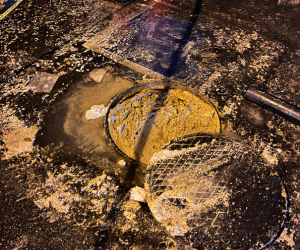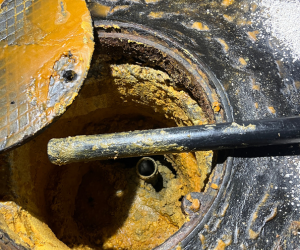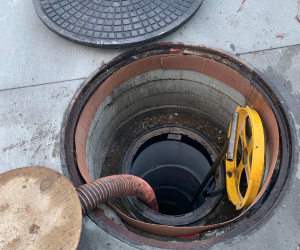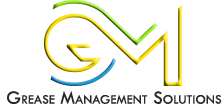Grease Interceptor Pumping & Cleaning
Home
>
Grease Interceptor Cleaning
Contact Us
Contact Us
Services We Provide
Do you Need Emergency Services?
We’re available for fast, reliable emergency service when you need it most. Whether it’s a leak, overflow, or urgent pickup, our team is ready to respond- just give us a call.

What is a grease trap / grease interceptor?
Similar functions of grease trap, the main difference that sets a grease interceptor apart is the size ranging from 500 gallons and above. Grease interceptors are usually found in ground installed in the parking lot of the establishment covered with manholes similar to the photo shown to the left. Its main function is to trap fats, oils, greases, and settled solids from commercial kitchens before entering the city sanitation line.
Interceptor Pumping and Cleaning
When cleaning a grease interceptor, it is important that all waste is removed from top to bottom. Unless, there is a problem with the interceptor such as an overflow or blockage content removed should be the rated size with a variance of 8-10%. In most cities, it is required for grease interceptors have 25% or less grease and settled solids. Once it reaches the 25% level, it is imperative that the device is completely pumped to prevent any citation from the inspectors. Depending of the size of the interceptor or amount of FOGS waste produced by the restaurant or establishment, grease interceptor cleaning will typically vary between 1-3 months on average. Failing to clean the device on a timely manner reduces its effectiveness, enabling it to release excess fats, oils, greases, and solids out to sewer and city sanitation lines.

Complete Pumping Service
Grease Management Solutions offers complete pumping and cleaning service of outdoor grease traps and interceptors. Licensed and approved by the CDFA as inedible kitchen grease waste haulers, we are here to keep in compliance with all regulations pertaining to FOGS waste removal and disposal. With every service provided, our service will include a full compliance FOGS certification report.
- Excessive Fats, Oils, Grease & Solids Content
- Plumbing
- Corrosion
Keeping you in full compliant with any FOGS related regulation is our job. Our grease interceptor cleaning experts are fully licensed by the CDFA to remove, haul and dispose grease trap waste content. Call us today to get a quote at 888-696-9906.
If you have recently pumped and cleaned device and are experiencing an overflow, odds are your outbound line leading to the sewer is clogged. Since grease traps does not retain majority of the grease and food solid waste, the FOGS escaping will adhere to the pipe eventually causing heavy build up that needs to be cleaned from time to time with a hydro jetting machine. A hydro jetter is the best remedy to restore the plumbing back to its original condition.
Grease traps over time can corrode eventually ending its life span. Due to the high acid content flowing into the device, it will cause it to rust weaking the metals causing it to leak. Leaks caused by corrosion are usually found on the side or the bottom seams of the device. It is likely that when these devices do leak that it will be more cost effective in the long run to replace it compared to repairing.
How To Clean A Grease Interceptor?
Cleaning a grease interceptor must be done by professionals who are licensed and have the proper machinery. Due to its large size, it is important the servicer have the proper equipment that can fully remove the complete content of the device. Since grease interceptors are made to trap grease and solids using the water as the separator, it is necessary to first skim the grease from the top, remove the water in the middle and finally the solids that settles in the bottom of the device. Failing to remove all content can lead to overflows and costly clean up.
Removal of fats, oils, grease, waste water, and solids
We thoroughly remove all fats, oils, and grease from the interceptor to prevent blockages and maintain proper system flow.
Visual inspection of inlet and outlet baffles
We inspect inlet and outlet baffles for damage or buildup to ensure proper grease interceptor function and regulatory compliance.
Scraping of accessible inner walls
All reachable interior walls are carefully scraped clean to eliminate grease buildup and reduce odors and future blockages.
Complete manifest report
We provide a detailed manifest report documenting services performed for your records, audits, and environmental regulation compliance.
Removal of fats, oils, grease, waste water, and solids
We thoroughly remove all fats, oils, and grease from the trap to prevent blockages and maintain proper system flow.
Visual inspection of inlet and outlet baffles
We inspect inlet and outlet baffles for damage or buildup to ensure proper grease trap function and regulatory compliance.
Visual inspection of inlet and outlet baffles
We inspect inlet and outlet baffles for damage or buildup to ensure proper grease trap function and regulatory compliance.
Complete manifest report
We provide a detailed manifest report documenting services performed for your records, audits, and environmental regulation compliance.
Keeping your grease interceptor clean and your establishment in compliant with the city and health regulations our job. Our team of haulers are fully licensed by the CDFA to remove, haul and dispose grease interceptor waste content. Call us today at 888-696-9906 and get a free QUOTE.
FAQ about Grease Interceptor Cleaning Services
How Often Should A Grease Interceptor Be Pumped?
There are many different factors to determine how frequently a grease interceptor is cleaned. Factors such as size of the interceptor, amount of food being produced in the kitchen, type of waste going into the kitchen drains, etc.. In many cities, throughout Los Angeles, Orange, Ventura, San Diego, Santa Barbara, San Bernardino, Riverside and San Luis Obispo, the city will require the traps to be cleaned once the content reaches 25% Fat, Oils, Grease and Solids or every 3-6 months depending on the size.
What Will Happen if I Don’t Maintain My Grease Interceptor?
Failing to properly maintain or clean the GI can lead to major overflows and line blockage. When grease interceptors exceed 25-30% FOGS content it increases the probability of a line stoppage inside the kitchen or lead to an overflow having grease leak out of the lids or covers. Hence, having an overflowing grease interceptor is not only dangerous to the public but can also be smelly and most of all be very costly to clean up. Since grease floats to the top of the device when overflows occur, it will most likely be the grease coming out first followed by the waste water. Therefore, with the interceptor being the heart of your kitchen drains it’s imperative that this device is maintained properly in order to reduce the odds of blockages and overflows.
What is the cost to clean a grease interceptor?
The price and cost of cleaning a grease trap start at $500 for devices that are regularly maintained and cleaned regularly. Grease traps that have been neglected and have not been cleaned exceeding the 25% FOGS level are subject to higher cost. Devices that have substantial amount of grease and food solid waste have higher cost of disposal fee. Call us today to learn more about grease trap cleaning price at 888-696-9906.
Ready to Get Started?
Trust GMS (A proud partner of The Grease Company, LA) for all and any of your commercial plumbing need. No matter what the time is, we’re always here for you.
News & Articles | Knowledgebase for our Customers

What is Greas oil collection
Duis aute irure dolor in reprehenderit in voluptate velit esse cillum dolore eu fugiat nulla pariatur.

What is Greas oil collection
Duis aute irure dolor in reprehenderit in voluptate velit esse cillum dolore eu fugiat nulla pariatur.

What is Greas oil collection
Duis aute irure dolor in reprehenderit in voluptate velit esse cillum dolore eu fugiat nulla pariatur.

What is Greas oil collection
Duis aute irure dolor in reprehenderit in voluptate velit esse cillum dolore eu fugiat nulla pariatur.
